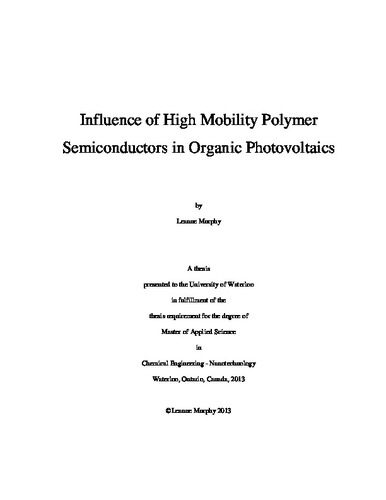| dc.description.abstract | Increasing global energy demands and diminishing supplies of conventional fuels are forcing the world to focus more on alternative power sources that are both renewable and ecologically benign. Solar energy is clean, regularly available and can be harvested without sacrificing valuable land space. Due to the associated cost of solar cells, however a very small portion of the world’s energy needs are supplied by the sun. Solution-processable organic photovoltaics (OPVs) offer the promise of lower production costs relative to conventional (silicon) solar cell technology. Solution-processing can be performed using reel-to-reel manufacturing, with printing and coating techniques that are significantly cheaper than current processing methods for inorganic semiconductors. Although OPV efficiency values currently remain inferior to those of conventional solar cells, the rate of improvement is much higher in OPVs than in other solar cell technologies. Recently an efficiency exceeding 10% was reported for organic solar cells.
An important difference between organic and conventional solar cells is the charge carrier mobility of the semiconductors, which tends to be relatively low in organic semiconductors. Recent advances in molecular design have led to polymer semiconductor materials that possess hole mobility values similar to that of amorphous silicon. The present study investigates potential improvements in OPV devices that can be achieved through the application of high hole mobility polymer semiconductor donors.
Two diketopyrrolopyrrole-based polymers, PDQT and PDBFBT, were selected for the role of electron donor in OPV devices due to their high mobilities and their optimum optical and electrical properties. Optimization of the process parameters was performed using PC61BM as the acceptor. A relatively high quantity of PC61BM (3 - 4 × the weight of the donor) is required in the donor-acceptor blends of both polymers in order to balance the high hole mobility. For these donor-acceptor blends, a solvent system consisting of chloroform/ortho-dichlorobenzene (4:1 v/v) is necessary for proper solubility, and an additive, 1,8-diiodooctane, is required to achieve an acceptable morphology.
The main benefit expected from the use of high mobility semiconductors is reduced charge recombination. This was studied in relation to the active layer thickness in standard and inverted OPV devices prepared using PC61BM as the acceptor. Normally the thickness of the active layer is required to be low (~100 nm) due to the poor charge transport mobility of the carriers. In this study, rather consistent power conversion efficiencies were achieved throughout a wide range of active layer thicknesses (~100 nm to ~800 nm). A comparison between standard and inverted device configurations demonstrates that the inverted configuration is more suitable for achieving thicker active layers when a high hole mobility donor is used. This is attributed to the longer hole collection path in the inverted structure, which can benefit from using a high hole mobility material.
Increasing the absorption spectra of the donor-acceptor blend was studied by substituting PC71BM for PC61BM. The improved absorption leads to greater charge generation. In PDQT devices, the increase in absorption that is contributed by PC71BM appears to be of greatest benefit when active layers are not very thick. Therefore, when thick active layers (>500 nm) are required, the use of PC61BM is sufficient, in conjunction with a high mobility donor.
Finally, an increase in a polymer’s crystallinity can often lead to greater mobility. This can be accomplished through various annealing techniques. The improved crystallinity of PDBFBT that occurs as a result of thermal annealing was studied in OPV applications. Although hole mobility of PDBFBT in the lateral direction improves with thermal annealing, mobility in the vertical direction decreases with increasing temperature. This suggests that the crystallinity of PDBFBT is oriented in the lateral direction as opposed to the vertical direction, thereby directing charge flow horizontal to the surface. With thermal annealing, an optimal amount of PC61BM added to PDBFBT can increase the vertical mobility to fairly high values. Nevertheless, the efficiency of standard and inverted OPV devices decreases with increased annealing temperature. This is attributed to agglomeration of PC61BM that occurs from an increase in annealing temperature. The results of this study demonstrate that thermal annealing is not beneficial for PDBFBT:PC61BM films in OPV applications due to the vertical orientation of devices.
All of the studies presented in this work involve the use of high hole mobility polymer semiconductors as donor materials for OPV applications. This work will provide a deeper understanding of the properties required for the development of new semiconductor materials in OPV applications. Furthermore, this work will be very useful for the design of device structures for more feasible manufacturing of large area OPV devices via high speed roll-to-roll printing processes. | en |

